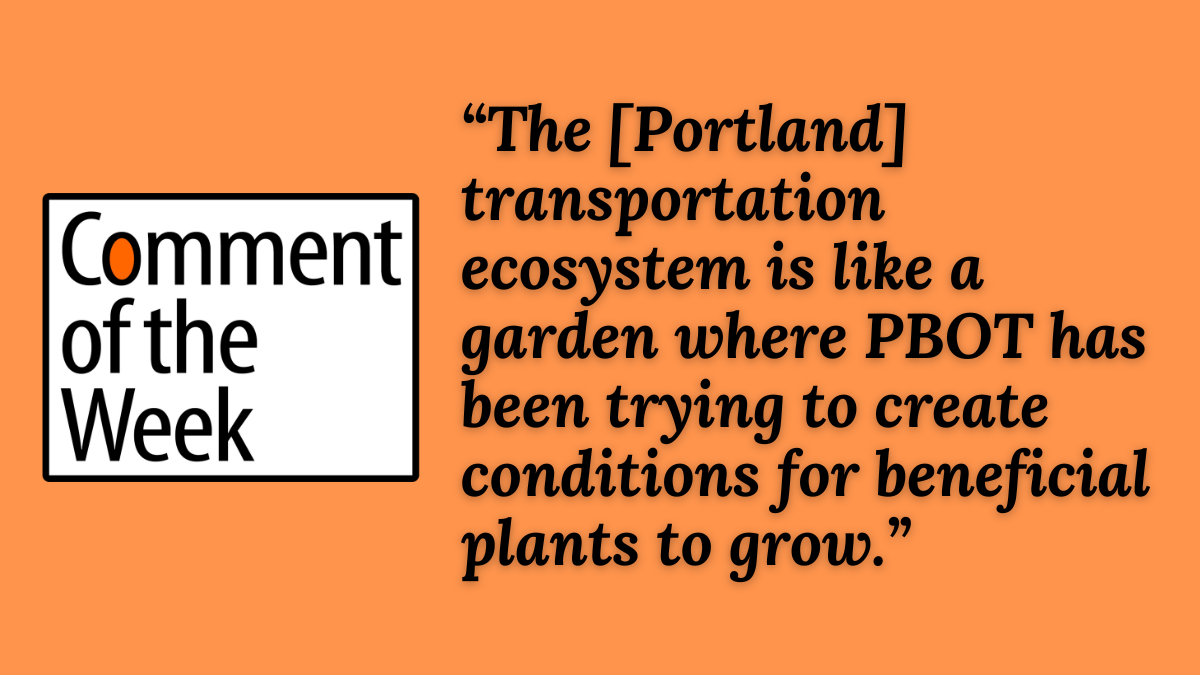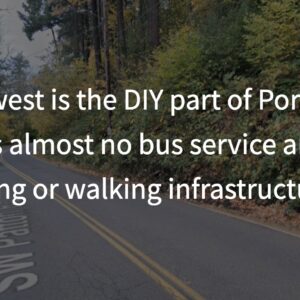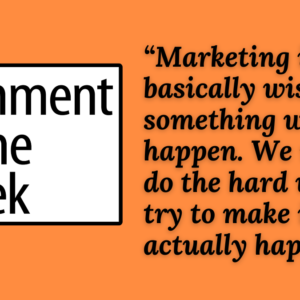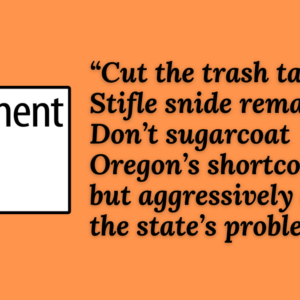
The new year is a time for reflection and vision, and several commenters this week described the Portland they would like to see. They could all envision, or remember, a city which felt vibrant, appealing, alive with possibility, a little collection of poignant letters about a city a lot of people love.
One commenter always gets points for punchy writing and passion, here’s what SD would like to see, and what it would take to get there:
Real transportation reform that could provide safe, affordable, efficient transportation for the Portland region will require a leap forward championed by a coalition of state and local leaders rather than incremental prodding and piecemeal projects; a clear coordinated message where the political heat is absorbed across multiple agencies. They should go big to get people excited and bring out the strong grass roots support for a livable vibrant city. Nobody should die on Portland streets, but more importantly every Portlander should feel alive on Portland streets.
The current transportation ecosystem in many ways is like a garden where PBOT has been trying to create conditions for beneficial plants to grow that provide beauty and sustenance. However, they are too timid to remove the toxic invasive weeds that will never let the desirable plants thrive. All of the water, compost and flexi-posts in the universe are not going to shift the equilibrium to create a Portland where someone can walk a couple miles and feel energized by being in a city rather than threatened by noise, pollution and the selfishness of drivers. There needs to be a city-wide vision that is clearly communicated to the public.
PBOT can’t make a transformative change on their own. They need a full-throated, coordinated campaign from all public agencies as if they are starting from square one. They need to get leaders of the business community that don’t suck to endorse the plan. They need to put ODOT’s 100 million dollar PR budget toward something useful and life affirming. All the pieces are here, Portland just needs leaders that want Portland to lead the US into a rational future. Portland doesn’t need second-career discards that want Portland to be an incubator for mediocre politicians.
The line about a “coordinated campaign from all public agencies” is particularly relevant to me today. Later, I’m meeting a friend at Goose Hollow. I have to drive because my bus doesn’t run past 8:00 AM. Even if I could walk the mile or so, various city bureaus have made it more difficult for me to do so. The city allowed a couple of property owners along the route to close right-of-way cut-throughs between streets, which adds about 15 minutes to the travel time. (One homeowner actually jackhammered a public staircase to bits — with no repercussion).
In fact, I can think of several examples near me where, either through an oversight or no sight at all, the city has made it more difficult to travel by foot. It’s been a drip-drip-drip over the years, and protecting the ROW requires a lot of vigilance on the part of the neighborhood. But really, the whole city, not just the Planning section of PBOT, should value and protect pedestrian and cyclist passage.
So thank you SD. You can read SD’s comment in context under our Five Dead in Three Days: A Grim Holiday of Predictable Traffic Violence in Portland post — in a thread that ran wild over the holiday weekend. Thank you to everyone who posted!






Thanks for reading.
BikePortland has served this community with independent community journalism since 2005. We rely on subscriptions from readers like you to survive. Your financial support is vital in keeping this valuable resource alive and well.
Please subscribe today to strengthen and expand our work.
Given the repercussions of the 1992 ADA, I’ve always wondered what was going to happen to public infrastructure that literally “doesn’t make the grade.” Now we know.
I’m not following you, David. It was a problem with an individual property owner requesting that the city vacate a ROW. The city agreed to, and my understanding is that the property owner then tore out the cement staircase leading to the ROW.
A useful public staircase is gone. Neighbors not wanting a ROW near or on their property is a continual problem in SW, often they just block it. ADA didn’t figure into any actions.
It’s the tragedy of the commons, but in a different way. I imagine the SW owner, depending where — sounds like around Goose Hallow — probably doesn’t mind the family with a dog using the stairs, or a few runners getting in some cardio, it’s the ones who leave piss, feces, trash and drug paraphernalia. I see it all over. I get why they tore it out. Of course, this is all conjecture, but an all too familiar scenario, I guess you can call me cynical…
That’s a concern Matt. I remember not long ago when people were defecating on the Elevator stairs off Broadway Drive. Maybe they still are. But I also know that there are people who, by nature, really can’t stand having the public anywhere near their property. It always stuns me, but there are people in my neighborhood who actually remove the sidewalk in front of their house!
Where was the staircase that was removed? (jackhammered).
We have wonderful staircases all over SW, and NW too. They are a civic treasure. Laura O. Foster even wrote a book about them (sadly no longer in print but available used).
Had I known – had many of us known – that the city was vacating an ROW, we would have protested.
Hi Fred,
I didn’t find out about it until 2019, and what I know is from a report that someone else made. I never used this route when it existed, usually I was headed to the stadium and walked over the Vista Bridge.
From that report, below is a photo of the staircase. I vaguely remember checking it out at in 2019, and seeing that stairs had been jack hammered, at least at the bottom.
This is a map of the larger surrounds. The ROW in question is the one running from just under the Market Street Drive label to the deadend of Mill Street Terr.
My feeling at the time was that the best approach to reopening the ROW would be for a local neighbor to spearhead the effort. No one ever stepped up. Plus, I think it is in the Goose Hollow neighborhood. My understanding is that years ago they had been involved in trying to get it reopened.
It’s a damn shame, but also got some complicated history that I have never understood (I have a copy of a 1913 deed that mentions the ROW.)
But, to SD’s larger point, it shouldn’t be up to neighborhood activists, or a small group in PBOT to shoulder all the responsibility for protecting ped/bike facilities, the entire city government should be educated and on-board with this.
The solution to the tragedy of the commons is to … reclaim the commons for the public good, not remove the commons entirely.
Hence the tragedy…
What a great post and worthy COTW! I rode in to work this morning along Naito, and I was speculating why the street is so insufficient. Naito runs between downtown and a riverfront park from the Steel Bridge to just south of the Hawthorne Bridge. The park is big with nice paths, good lighting and benches, extensive lawns and large trees and it it sits right on the river with beautiful views of the water, our bridges and across to the east side and beyond to Mt Hood. The property along Naito should be the most desirable in the City. Development history is partly to blame- this is the oldest part of town and many of the buildings are small, and many of the City’s services were located in Old Town and near the river for years. But the design of Naito is also problematic. It is designed almost exclusively to move cars, and the Better Naito project did little to change that. Southbound is still 3 traffic lanes (2 driving + 1 bike) + a parking lane. As I rode south this morning, I watched cars speeding down those lanes, trying to weave around and pass each other to beat signals and I wondered, why didn’t they make that 1 driving lane with head-in parking? Why didn’t they take down the ramps that connect Naito to the Morrison Bridge- this highway-style infrastructure is terrible for pedestrian environments, but would require coordination between ODOT, Multnomah County and PBOT. Imagine the southbound lane rebuilt and the ramps gone and new curb extensions closing the crossing gap to the park! Maybe some of the park festivals could be hosted on the land where the maps are now so less of our park is fenced off during the summer. I could go on about Naito, but I just want to second the thoughts of SD!
Southbound also has two “pedestrian lanes” (AKA wide sidewalk), and northbound has 1 car lane, 2 bike lanes, and a bi-directional pedestrian lane, for a total of 3 auto lanes, 1 parking lane, 3 bike lanes, and 4 pedestrian “lanes”. And that’s not counting the major pedestrian promenade along the river itself, which is where most people want to walk.
There are frequent high-quality pedestrian and bike crossings.
I don’t claim the facility is ideal, but “by the numbers” it’s great, and the experience of riding on it is pretty good when there’s not a lot of other folks on it (which is most of the time these days).
The ramps are not optimal in some ways, but are useful when you want to get from Naito to the Morrison Bridge, in a car or on a bike.
What you’re missing here is how the street design AFFORDS – and actually REWARDS – aggressive driving behavior.
Because four-lane urban highways are ubiquitous in Portland and the USA generally, many drivers today expect to be able to speed around cars that are obeying the speed limit – and there are absolutely no repercussions for bad behavior. In fact, there are rewards: drive dangerously, with no regard for anyone outside of your vehicle, and you get where you’re going faster.
The design of Naito and other four-lane urban highways CREATES the conditions that promote anti-social behaviors.
Unless you have a registered car to a current address and speed cameras correctly identify the license plate.
Ooops, we don’t really enforce that anymore so it doesn’t work for a good fraction of the population.
Agreed.
I’ve likened this to inflation – even as bicycle infrastructure improves, if surrounding conditions worsen quicker, the overall cycling environment is net negative. Just like your 3% raise in a 7% inflationary year.
The Glenn Jackson bridge path is a great example. It’s a separated, fully protected bike lane! No intersections or driveway conflicts! On paper, absolute perfection in terms of bicycle infrastructure. Is it nice to ride? Absolutely not. Why not? The surrounding conditions (e.g., freeway automobile traffic – I’ve also never ridden that path without encountering some car parts from some accident or another, so even that aforementioned protection seems continually challenged. Though I will readily confess I haven’t ridden it in a number of years now).
I’m not missing it; my point was that it doesn’t impact me because of the location of the bike route and the quality of the crossings. I used to ride in the SB bike lane daily (that never felt particularly bad as an assertive rider, but would have sucked for a more timid one), but I have now switched completely to the bi-directional path on the river side of the street.
The bad behavior you describe is no longer a factor in my experience of riding on Naito — it’s on the far side of a concrete median and there’s a lane of oncoming traffic providing further protection.
I agree that is is ok to drive on and even bike on, but because of this, Naito is effectively a barrier between downtown and the riverfront park. It is possible to move cars and bikes along Naito but prioritize pedestrian connection that support recreation and commercial success along Naito. This could be a vibrant street, but it is not.
There are already good crossings of Naito (they feel generous, wide, and safe). How would you continue to move cars and bikes along the street while enhancing recreation and commercial businesses along Naito?
I think a big part of the problem is that when people are walking N/S, they want to do so by the river, not on the street.
I would remove the ramps to the Morrison Bridge. I would reduce the southbound travel lanes to just one driving lane. I would make the parking on the south side head-in parking and corresponding curb extensions. I would eliminate the slip lanes. I would add more median trees. I would remove all the beg buttons and give pedestrians regular, dedicated time to cross. I would alos restore the cross walks across Naito at Morrison and across the Morrison bridge ramp along 2nd.
The days of PBOT considering anything beyond narrowly defined traffic quantity goals are gone (they used to be excellent at this!). The City needs some bureau to establish urban design/livability planning goals and have some way of requiring these goals are conveyed to PBOT project managers and met within their designs.
When reading this story, the comments and writing this comment, I thought a lot about governor Kotek’s recent “task force” for downtown Portland. I was wondering where the state level coalition for transportation violence and pollution is hiding. Clearly, leaving this task to ODOT, PBOT, metro and the county in their current configuration is not working.
A good place to start is a commitment to de-commission the freeway network in Portland, starting with the Eastbank Freeway and Marquam Bridge…a huge mistake when it was built in the ’60’s. What’s wrong with Waterfront Park and SW Naito? Cross the latter and enter the former, and you look out onto our River, but what catches your attention is the roar and bulk of twelve lanes of motor vehicle traffic on I-5. What stronger statement could we make as a community to address global warming than to unite for I-5’s removal and replacement with a vibrant, new city district with housing & commerce hugging our River.
Absolutely. That freeway is a blot on the landscape and an enormous waste of resources.